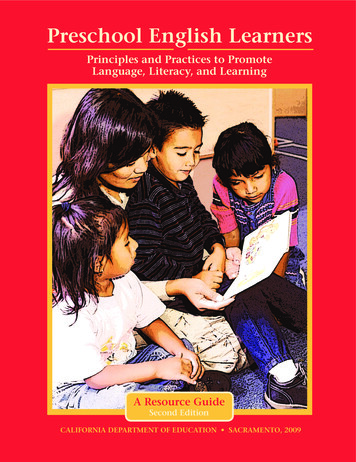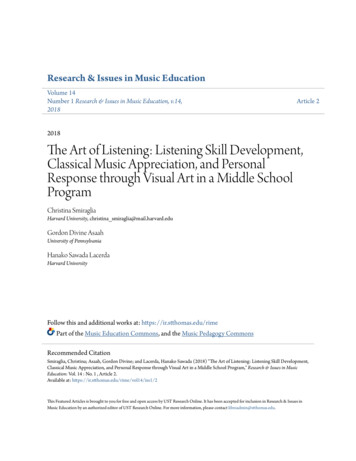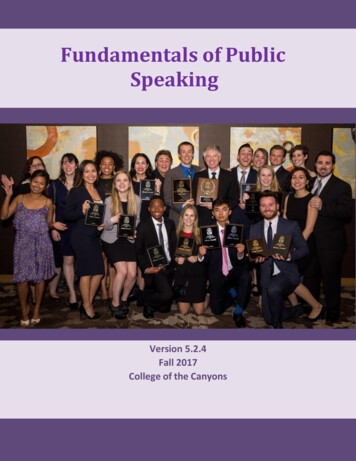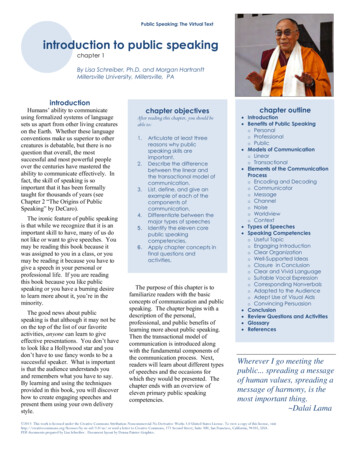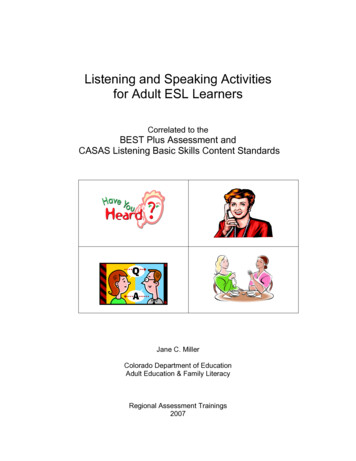
Transcription
Listening and Speaking Activitiesfor Adult ESL LearnersCorrelated to theBEST Plus Assessment andCASAS Listening Basic Skills Content StandardsJane C. MillerColorado Department of EducationAdult Education & Family LiteracyRegional Assessment Trainings2007
1IntroductionAdult ESL learners have countless daily opportunities for listening and speaking in English as they interactas workers, family members, community members, and classroom learners. Some listening is non-faceto-face, such as listening to movies and broadcast media, listening on the phone, and listening toloudspeaker announcements. Most listening, however, combines short bursts of face-to-face listeninginterspersed with speaking – such as discussions at the workplace, social conversations with neighborsand colleagues, telephone conversations, and conversations with the many service providers encountereddaily – doctors, social workers, police officers, store clerks, and school staff.In each context, learners have a purpose for listening and a communication task. Listeners may listen toobtain facts or to understand the main idea. They may need to distinguish question words and respondappropriately. They may need to follow or give instructions or advice. Adult learners may need todistinguish facts from opinions or express their own point of view. They may need to relate what theyhear to visual materials they are looking at. They may want to connect with other people by sharingpersonal stories.Many factors can interfere with listening and speaking to create confusions and miscommunications.Misheard sounds and pronunciation errors, inappropriate word choices or wrongly-used grammaticalforms can lead to communication breakdowns. Breakdowns can have significant consequences –embarrassment, unintended offense, missed appointments, inaccurate processes, etc.ESL teachers have the opportunity to help adult ESL learners practice listening and speaking in the safeenvironment of the classroom. Many textbooks contain listening cassettes or CDs which give learners theopportunity to hear voices from a variety of speakers engaged in conversations on a variety of life skilltopics. In addition, teachers can facilitate listening and speaking activities that utilize pair work andgroup work. Every listening/speaking activity should require a response; the listener should answer aquestion, follow a direction, choose the correct object from alternatives, write a message, etc.This packet of listening and speaking activities contains just a few of the hundreds of activities availablefor classroom instruction. The activities are directly tied to two of the listening/speaking assessmentsused in adult ESL programs – the BEST Plus assessment of oral language proficiency and the CASASListening test. The activities are organized by the three skills of language scored in the BEST Plusassessment: Listening Comprehension, Language Complexity, and Communication. For each activity thedescription notes the real world purpose, what the learner will listen for, what the communication task is,and which of the CASAS Listening Basic Skills Content Standards are addressed by the activity.The activities are not tied to any particular learner proficiency level. Activities are listed in eachsubsection in a general progression from most simple to most complex. It is assumed that ESL teacherscan read the description of an activity and know ways to adapt it, if necessary, to the level of learners inher classroom. Some activities are described as whole-class activities led by the teacher. Many arelearner-to-learner pair or group activities. Most teacher-led activities are to be read aloud so learnersbenefit from the visual clues of facial expression and mouth movement. However, these activitiesoptionally can be tape recorded to give learners practice in non-face-to-face listening. The greatest valueof using these activities is that listening instruction becomes an intentional focus of classroom instruction.Jane C. MillerESL Specialist and Professional Development CoordinatorColorado Department of Education, Adult Education and Family Literacymiller j@cde.state.co.usLinking ESL Instruction to the BEST Plus and CASAS Listening AssessmentsJuly 2007 CDE/AEFL, Jane C. Millermiller j@cde.state.co.us
2Characteristics of an effective listening activitythe listening “text” is brief (1 – 3 minutes)a purpose for listening is identified and shared with learnersthe listening “text” is supported by visual cluesthe listening activity requires a response thato indicates comprehension of the listening cueo is intermittent with aural cues – not just at the end of the listeningo is simple, easy to completethe listening “text” is repeated several times1. to get the gist2. first pass on completing the task3. second pass on completing the task4. check the individual work5. debrief with the teacher and classmates6. warm up to the next classthe activity provides immediate feedbackthe activity has elements that contribute to motivationo relevancy – life skill topico high interesto challenge – puzzle to solve, task to completeo is success-oriented to engender confidenceFacilitating listening/speaking activities1. Help learners focus their attentiona. Introduce the content of the task. Tap learners’ background knowledge2. Set up the activitya. Explain the purpose of the activityb. Explain the process for completing the taskc. Model the task for the class3. Let the learners do the activity (whole class, pairs, groups)a. Observe their progressb. Note their successes and challengesc. Repeat the activity (with new partner, with additional readings of the oral text, etc.)4. Evaluate the activitya. Provide an answer sheet if appropriateb. Elicit learner feedbackc. Provide feedback on learner performance5. Provide follow upa. Use the listening and/or speaking activity as a lead-in to the next classroomactivity, as the basis for a homework assignment, and as the next day’s warmup.Linking ESL Instruction to the BEST Plus and CASAS Listening AssessmentsJuly 2007 CDE/AEFL, Jane C. Millermiller j@cde.state.co.us
3Listening ComprehensionHow well does the learner understand the typical daily language of a fluent Englishspeaker?BEST Plus Teaching PointsDistinguishing wh-question words and question typesListening for detailsListening to extended speechClarification strategiesCASAS Listening Basic Skills Content StandardsL1L2L3L4L5L6Recognizing vocabularyUnderstanding imperatives, instructions and requestsInterpreting grammatical structuresUnderstanding conversationUnderstanding non-face-to-face speechComprehending informational and factual discourseActivities to distinguish question words and types:LC1Answering Simple QuestionsReal-world purpose:Listen for:Communication task:CASAS ContentStandards:To understand English question words and respond appropriatelyQuestion wordsAsk and answer questionsL1.5, L3.3, L3.4Elicit list of level-appropriate yes/no and Wh-questions that are pertinent to the life skilltopic or subject matter currently being studied. Elicit 1-2 possible responses to each question.Put learners in pairs. Pairs ask each other the questions and provide answers.Linking ESL Instruction to the BEST Plus and CASAS Listening AssessmentsJuly 2007 CDE/AEFL, Jane C. Millermiller j@cde.state.co.us
4LC2Picture DescriptionsReal-world purpose:Listen for:Communication task:CASAS ContentStandards:To understand English question words and respond appropriately.To relate aural cues to visual information.Question wordsAsk and answer questionsL3.3, L3.4Find a large magazine photo or textbook illustration that shows a specific setting (a city,park, kitchen, school, office, hospital, store etc) and several people engaged in one or a varietyof activities. Show the picture to the entire class (or provide each student with a photocopy)and ask a series of Wh-, yes/no, and “or” (choice) questions related to the picture. Elicitresponses from learners. Some responses will be based on direct evidence in the picture; otherresponses will be imagined or inferred. For additional practice, put learners in pairs. Membersof the pair each have a turn being the “teacher” who asks questions about a picture and the“learner” who answers the questions.LC3Class Story Using Language Experience ApproachReal-world purpose:Listen for:Communication task:CASAS ContentStandards:To engage in social conversation. To distinguish English questionwords and respond appropriatelyQuestion wordsAnswer questionsL1.2, L3.4As a class, or from one learner, elicit an account of a real experience from work,community, family or friends. Using simple sentences, write the account on the board as thelearner speaks. When finished, orally ask comprehension questions about the account writtenon the board. Utilize a variety of WH-information questions, yes/no questions, and “or” (choice)questions.LC4It Happened Last WeekReal-world purpose:Listen for:Communication task:CASAS ContentStandards:To engage in social interactions. To describe one’s personalexperiences and to inquire about another person’s experiences.What people did. Names, times of day, location words.Get more information by asking past tense questions.L3.3, L3.4, L3.5, L3.7, L4.2, L4.4Elicit question words from learners and write them on the board (who, what, where,when, why, how, how long, how many/much, how often), do/did, and is/are, was/were .Explain that you will tell a brief story (1-2 sentences) about something that happened in yourlife the previous week. Example: My family went on a trip this weekend.” Tell learners tothink of questions to ask you in order to get more details about your story. When finished withLinking ESL Instruction to the BEST Plus and CASAS Listening AssessmentsJuly 2007 CDE/AEFL, Jane C. Millermiller j@cde.state.co.us
5all the learners’ questions and your answers, put learners in pairs. The first member of the pairtalks briefly about something that happened to him/her last week (at work, with their family,with friends, etc.) The second member of the pair listens and asks follow up questions – tryingto form a question for each of the six Wh- information question words. The first memberanswers the follow-up questions, elaborating on the story as initially told. Members of the pairswitch roles so each person has a chance to tell a story and answer questions and each personhas a chance to ask follow up questions.LC5My Favorite Gift – 20 questionsReal-world purpose:Listen for:Communication task:CASAS ContentStandards:To engage in social interactions. To describe one’s personalexperiences and to inquire about another person’s experiences.Names of people and things, descriptions of what happenedGet more information by asking past tense questionsL3.3, L3.4, L3.7, L4.2, L4.4Explain that you once received a gift that has become your favorite. Say that you wouldlike learners to ask you questions in order to get details about the gift. Answer each questionas you also write the question on the board. Provide additional questions and your answers asneeded. When finished, describe the favorite gift in full, including all the answers to thequestions as a demonstration of organized, elaborated speech. Then put learners in pairs. Thefirst member of the pair thinks of a favorite gift. The second member of the pair asks questionsabout the gift using the questions on the board as necessary. The first member answers eachquestion one by one and finishes by describing the favorite gift in full. Members of the pairswitch roles so each person has a chance to ask and answer questions about a favorite gift.For additional practice, conclude by asking certain learners to describe their favorite gifts to theentire class.Additional themes Pairs can speak about their favorite house, teacher, birthday celebration,trip, etc.LC6InterviewsReal-world purpose:Listen for:Communication task:CASAS ContentStandards:To respond to interview questions. To engage in social interactions.To share personal experiences. To complete a task.Question wordsAsk and answer questionsL1.4, L3.1, L3.3, L3.4Ask the class to brainstorm a list of 3-5 level-appropriate yes/no, Wh-, and “can”questions that are pertinent to the life skill topic or subject matter currently being studied.When appropriate, yes/no questions should be followed by “Why?” or “Why not?” Provide eachstudent with a grid on which they write the questions. Have learners walk around theclassroom, self-selecting partners with whom to interview. Partner A asks the questions andLinking ESL Instruction to the BEST Plus and CASAS Listening AssessmentsJuly 2007 CDE/AEFL, Jane C. Millermiller j@cde.state.co.us
6writes Partner B’s responses onto the grid. Partners A and B reverse roles. Learners shouldinterview 3-4 different partners.Sample grid:QuestionWhat do you like to do inyour free time?Do you like to watch TV?Why? or Why not?Which sport is yourfavorite? Why?Is there a park near yourhouse?Can you ride a bike?LC7In the NewsReal-world purpose:Listen for:Communication task:CASAS ContentStandards:Student 1ElenaPlay with herchildrenNo. Notenough time.Dancing,because it isbeautiful andfun.Yes. She takesher childrenthere everyday.No, she can’tStudent 2HectorWork on hiscars.Yes becauseit isrelaxing.Car racing.It isexcitingStudent 3NatalyaMake agarden.Yes. She likesTV stories offamilies.Swimming,because it isrelaxing.No.Yes. It’sacross thestreetYes, he can.Yes, she can.Student 4TarasTo understand and discuss current news events.Facts. Answers to questionsAsk and answer questionsL1.4, L3.3, L3.4, L3.7, L5.1, L6.4, L6.5Read aloud a very short news story – 1-2 paragraphs. Ask learners to generate questionsabout the story, using the WH-question words. Write the questions on the board. Put learnersin pairs (or leave as a whole group). Read the story aloud again. Ask learners to ask andanswer the questions orally from the board. To give learners practice understanding non-faceto-face speech, record the article on cassette and play the cassette rather than reading thearticle aloud.Linking ESL Instruction to the BEST Plus and CASAS Listening AssessmentsJuly 2007 CDE/AEFL, Jane C. Millermiller j@cde.state.co.us
7Activities that develop listening for details:LC8Minimal PairsReal-world purpose:Listen for:CASAS ContentStandards:To hear accurately in order to avoid misunderstandingDifferent sounds at the beginning, middle, and ends of wordsL1.3Help learners distinguish between similar sounds at the beginning of words (pat, bat), inthe middle of words (lift, list), and/or at the end of words (have, has). Make lists of minimalpair sets (search for “minimal pairs” on the Internet).Same or Different? Have each learner make two 3” x 3” cards, one labeled SAME, one labeledDIFFERENT. Read a list of word pairs aloud, where some pairs are two different words(minimal pairs) and some are the same word read twice. As you read, each learner holds uptheir SAME or DIFFERENT card. Read aloud again until all learners correctly identify whetherthe words are different (minimal pairs) or the same word read twice.Same or Different Numbers? Follow the same procedure above, using number pairs (14/40;90/19, 15/15)Odd Word Out Have each learner make three 3” x 3” cards, labeled 1, 2, and 3. Read a list ofword trios aloud, where two words are the same and one is different (pat, bat, pat; lift, lift,list; has, have, have). As you read, each learner holds up the number card representing whichword in the trio was different from the other two. Repeat each trio until all learners correctlyidentify which of the three words is different.LC9DictationReal-world purpose:Listen for:CASAS ContentStandards:To hear accurately in order to avoid misunderstandingSounds, words, phrasesL1.4, L5.1Dictate level-appropriate words, phrases, or sentences to learners. Prepare answer sheetsso learners can check their own work. If it is level-appropriate, use dictation as a means toconvey announcements about upcoming class activities, program schedules, communityactivities, etc. The dictation content may be recorded on cassette tape in order to give learnerspractice in understanding non-face-to-face speech.Linking ESL Instruction to the BEST Plus and CASAS Listening AssessmentsJuly 2007 CDE/AEFL, Jane C. Millermiller j@cde.state.co.us
8LC10Cloze (gapped) DictationReal-world purpose:Listen for:CASAS ContentStandards:To hear accurately in order to avoid misunderstanding. To completea task.Sounds and words in contextL1.4, L3.7Locate a level-appropriate text that is pertinent to the life skill topic or subject mattercurrently being studied. You can write the text yourself, find a paragraph from a textbook, orfind a brief article in the newspaper. Using the same text, white out certain words, eitherrandomly (every 8th or 10th word) or intentionally-chosen (key content words or words oftenmisheard), to create “gaps”. (To help learners distinguish verb tense endings, “gap” some or allthe verbs.) As appropriate, make one gap every line or every other line. Before handing outthe gapped worksheet, read aloud the complete text while learners listen to get the gist. Next,hand out copies of the gapped text. Read the text aloud a second time while learners fill in the“gapped” words as they hear them. Read the text aloud a third time so learners can checktheir work. Use a natural pace each time you read aloud. Discuss the answers. The dictationtext may be recorded on cassette tape in order to give learners practice in understanding nonface-to-face speech.LC11Dialogue DictationReal-world purpose:Listen for:Communication task:CASAS ContentStandards:To hear accurately and to speak clearly in order to avoidmisunderstanding. To repair communication breakdowns.To complete a task.Words, phrases and sentencesRead sentences aloud, write sentences. Ask for clarification.L1.3, L1.4, L2.5, L3.6, L4.2Prepare (or obtain from a textbook) a short, level-appropriate dialogue that is pertinent tothe life skill topic or subject matter currently being studied. Separate the lines of the dialogueinto Student A and Student B parts, putting the lines on separate sheets of paper, leaving blanklines between. Put learners in pairs, sitting across the table. Learners alternately dictate theirlines of the conversation until both members of the pair have the entire dialogue. Remindlearners to use clarification strategies during the dictation (Could you please repeat that?Please speak slowly. How do you spell that? Is this right?) Learners then practice thedialogue together.Linking ESL Instruction to the BEST Plus and CASAS Listening AssessmentsJuly 2007 CDE/AEFL, Jane C. Millermiller j@cde.state.co.us
9LC12Past, Present, FutureReal-world purpose:Listen for:Communication task:CASAS ContentStandards:To hear and speak accurately in order to avoid misunderstanding.Verb endingsRead sentences aloud with clear pronunciation.L1.4, L3.7Prepare short lists of 10-12 level-appropriate sentences that are pertinent to the life skilltopic or subject matter currently being studied. The sentences should utilize verb tensesalready studied and practiced by learners. On the board, draw the following:PastRight NowFutureEvery DayRead a sentence from a list. Ask a volunteer to come to the board and point to the wordimplied by the verb tense used in the sentence. Example: I walk to work at 7:30. (point to“Every Day”) I walked in the park after dinner. (point to “Past”). Repeat if necessary.Complete one list with the entire class, then put learners in pairs. Give a list of sentences toeach Partner A. Ask each Partner B to draw the time line on a piece of notebook paper.Partner A reads each sentence aloud and watches to confirm that Partner B points correctly onthe time line. If Partner B is in error, Partner A repeats, attending more carefully topronunciation. Partners switch roles, so Partner B reads a new list and Partner A listens andpoints.LC13Picture Story Sequence IReal-world purpose:Listen for:CASAS ContentStandards:To hear accurately in order to avoid misunderstanding. To relateaural cues to visual information. To complete a task.Key vocabulary, adverbs of time, prepositions of location.L1.4, L2.5, L3.8, L6.7Locate or create a picture story sequence (6-10 pictures) that is pertinent to the life skilltopic or subject matter currently being studied. (The individual pictures are typically 2” x 2” sothey can easily be laid out on a single 8” x 11” piece of paper.) Prepare a written story aboutthe sequence using level–appropriate vocabulary and sentences. Make enough photocopies ofthe picture story sequence for two per learner. Set aside half the copies. With the other half,cut each sequence apart so you have one set of 2” x 2” pictures for each learner. Shuffle eachset so the pictures are out of sequence. Before handing out he picture sets, read aloud thecomplete text using a natural pace while learners listen to get the gist. Next, hand out sets ofthe pictures. Read the text aloud a second time while learners arrange the pictures in order.Read the text aloud a third time so learners can check their work and make any revisions.Hand out the uncut photocopies so learners can check their work. Gather the cut sets for reuseand let the learners keep the uncut photocopies for review. Learners can write the storysequence for homework and retell the story the next day in pairs.Linking ESL Instruction to the BEST Plus and CASAS Listening AssessmentsJuly 2007 CDE/AEFL, Jane C. Millermiller j@cde.state.co.us
10LC14Picture Description – That’s Not Right!Real-world purpose:Listen for:Communication task:CASAS ContentStandards:To hear accurately. To repair communication breakdowns. To relateaural cues to visual information. To make appropriate conversation.Words and phrases in context.Politely correct a person’s mistake.L1.4, L4.4, L6.5Find a large magazine photo or textbook illustration that shows a specific setting (a city,park, kitchen, school, office, hospital, store etc) and several people engaged in one or a varietyof activities. Have each learner make a 2” x 2” card, labeled “That’s not right!” Show thepicture to the entire class (or provide each student with a photocopy). Pre-teach any keyvocabulary. Give learners a few minutes to study the picture. Explain to learners that you’regoing to describe the picture. If you make any mistakes, they should hold up their “That’s notright!” card. Orally describe the picture, using level-appropriate vocabulary and sentences,occasionally stating something that is not true about the picture. For example, if the picturehas two boys, you might say three boys. Or if a person in the picture is running, you might sayswimming. Learners listen and when they hear a discrepancy between the oral account and theactual picture, they raise their card. Call on learners to say a corrected statement about thepicture. Teach the politeness strategies, “I think you meant to say .” or “I think yousaid . Did you mean to say ?”LC15Altered Texts and BroadcastsReal-world purpose:Listen for:CASAS ContentStandards:To hear accurately to avoid misunderstanding. To learn about currentevents. To complete a task.Words and phrases in context.L5.3Altered Texts Locate a short, level-appropriate text that is pertinent to the life skill topicor subject matter currently being studied. The 1-2 paragraph text can be written by you,obtained from a textbook, or clipped from a newspaper. Make copies of the original text foryour learners. On your copy, replace certain words or phrases with synonyms (explained/said,over/above) or similar words (Sunday/Monday, hiking/camping, coworker/neighbor, don’t/youshouldn’t). Read the altered text aloud while learners listen to get the gist. Next, give learnersthe original text. Read the altered text aloud a second time while learners read the original textand circle the locations of altered words or phrases. Read the altered text aloud a third time forlearners to write the alterations. Read the text a final time for learners to check their work.Altered Broadcasts You can also use a brief segment from a taped news broadcast. In thiscase, give learners the altered transcript, since they will be listening to the original text of thebroadcast.Linking ESL Instruction to the BEST Plus and CASAS Listening AssessmentsJuly 2007 CDE/AEFL, Jane C. Millermiller j@cde.state.co.us
11LC16Picture DictationsIn these activities, learners draw a picture as it is being described orally by the teacher.Real-world purpose:Listen for:CASAS ContentStandards:To hear accurately to avoid misunderstanding. To relate aural cues tovisual information. To complete a task.Nouns, verbs, description words, prepositions of location.L1.4, L3.2, L3.9, L6.3, L6.5Draw This Picture Find a large magazine photo or textbook illustration that shows a specificsetting (a city, park, kitchen, school, office, hospital, store etc) and several people engaged inone or a variety of activities. Don’t show learners the picture. Pre-teach any unfamiliarvocabulary you will use to describe the picture. Orally describe the picture, using levelappropriate sentences, and pausing between lines to allow learners to draw the picture (on aclean, 8” x 11” paper) while you describe it. Include some negative statements such as “Thewoman isn’t wearing a hat.” and confirm that learners don’t draw in response. Describe thepicture a second time to allow learners to check their work. When finished, learners comparetheir pictures to the original and to each others’ pictures.Unit Summary Picture At the end of a life skill unit of study, use the words and phrases learnedin the unit to write a story that can be visually depicted. Read the story aloud at a naturalpace while learners listen to get the gist. Next, give learners a blank sheet of paper and apencil. Read the text aloud a second time, line by line. Learners draw what they hear (anddon’t draw in response to negative statements). Read the text aloud a third time for learners tocheck their illustrations. When finished, learners share their illustrations.LC17Just the FactsReal-world purpose:Listen for:CASAS ContentStandards:To hear accurately in order to avoid misunderstanding. To understandcurrent news events.Words, numbersL1.3, L5.1, L6.3, L6.4Fill in the Answers Find a level-appropriate text on a topic of interest in the newspaper, asource book of interesting information such as an almanac or book of world records. Prepare a“fact sheet” of 5-10 questions that can be answered by learners while listening to you read thetext aloud. Pre-teach any key vocabulary. Before handing out the fact sheet, read the textaloud at a natural pace while learners listen to get the gist. Next, give learners the fact sheet.Read the text aloud a second time while learners listen and write the answers to the questions.You may allow learners to interrupt with clarification strategies such as “Could you pleaserepeat that?”, “How do you spell that?”, and “Did you say or ?” Read the textaloud a third time for learners to check their answers. Short articles about baseball games givemany opportunities to hear both cardinal and ordinal numbers. To give learners practiceLinking ESL Instruction to the BEST Plus and CASAS Listening AssessmentsJuly 2007 CDE/AEFL, Jane C. Millermiller j@cde.state.co.us
12understanding non-face-to-face speech, record the article on cassette and play the cassetterather than reading the article aloud.Choose the Correct Answer Rather than ask learners to listen to the text and write ananswer for each question, prepare the worksheet with a set of three, multiple-choice options,for each question. The multiple-choice options should be similar in sound. For example, if acrime occurred at 340 Marsh St., the choices could be a) 314 Marsh St. b) 340 March St. c) 340Marsh St. Learners listen to the text and circle A, B, or C for each question.LC18Maps and GridsReal-world purpose:Listen for:Communication task:CASAS ContentStandards:To hear accurately in order to avoid misunderstanding. To followdirections. To relate aural cues to visual information. To complete atask.Prepositions, names, numbers, clock times, phrasesUse clarification strategies to check understanding.L1.4, L6.3, L6.4Maps Provide learners a level-appropriate birds-eye-view illustration of a town, a shoppingcenter, or a building floor plan, with a few of the locations marked. Read a story that identifiesthe locations of other buildings, stores, or rooms. Learners listen a second time and label theillustration. You may allow learners to interrupt with clarification strategies such as “Could youplease repeat that?”, “How do you spell that?”, and “Did you say or ?” Read thetext aloud a third time for learners to check their answers.Grids Create a grid with rows and columns. Label the columns and, if appropriate, the rows.For example, if the topic is travel plans, the rows might include names of three travelers andthe columns could be labeled as follows: destination, departure date, flight number, departuretime, arrival time, hotel name, length of stay. Write a story that includes all the informationneeded to complete the grid. Before handing out the grid, read the story aloud at a naturalpace while learners listen to get the gist. Next, give learners the blank grid. Read the textaloud a second time while learners listen and write the answers on the grid. You may allowlearners to interrupt with clarification strategies such as “Could you please repeat that?”, “Howdo you spell that?”, and “Did you say or ?” Read the text aloud a third time forlearners to check their answers.Linking ESL Instruction to the BEST Plus and CASAS Listening AssessmentsJuly 2007 CDE/AEFL, Jane C. Millermiller j@cde.state.co.us
13Activities that develop listening to extended speech:These activities listed above provide learners opportunities to listen to extended speech:LC4 It Happened Last WeekLC9 In the
ESL teachers have the opportunity to help adult ESL learners practice listening and speaking in the safe environment of the classroom. Many textbooks contain listening cassettes or CDs which give learners the opportunity to hear voices from a variety of speakers en
